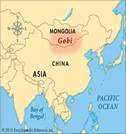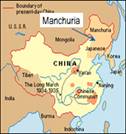By Kollengode S Venkataraman
One of the craziest items in Indian restaurants these days is Gobi Manchurian. The name sounded familiar for geographical reasons. I remember in my high-school geography taught in Tamil that there was a desert called Gobi. In the Tamil script, there is only one letter for both “Pa†and “Ba.†So, I read it as Gopi desert and thought this was the desert in northwest India around Gujarat and Rajasthan. I later learned that it was not Gopi, but Gobi desert; what was shocking was that it was not anywhere in India. It was between Mongolia and China, over 1000 miles from India’s northern borders. See map above.
In India, the craze du jour is Chinese food, with Chinese restaurants first appearing in upscale areas. And seeing a good market for Chinese food among the wannabe gora, but very brown desi “foodies,†Indo-Chinese restaurants sprang up everywhere, literally spicing up the traditional Chinese fare of noodles/rice with fish, chicken, lamb, and goat, but avoiding other Chinese delicacies, such as snake, turtle, and jelly fish that don’t sit well with Indians. Seeing a good demand for these modified Chinese fare, even 100% shudh vegetarian joints all over India started adding Chinese noodle items flavored with Indian spices and soy sauce, making hybridized Indo-Chinese items. One item — called Gobi Manchurian — became really popular in all Indian restaurants all over the world.
Again, I vaguely remember from my school geography, Manchuria was somewhere in China. Since Gobi Manchurian is popular in Indian restaurants, I thought Manchuria should be somewhere in the Indo-China border region. When I searched Google, I was in for another shock. Manchuria was in northeastern China bordering Russia, separated from India’s northern border by over 1000 miles. See the map on the side.
Then I went to northeastern China on work. In all the Cantonese, Hunan, and Shandong food I ate there, nowhere did I see anything called Gobi Manchurian. Not only was nothing called anything closer, but none looked anything like the desi Gobi Manchurian in presentation or taste.
Then I imagined that a Malayali cook, Gopinathan (Gopi for short), might have gone to northeastern China as a migrant worker. There he concocted a dish hybridizing his native Kerala-style cooking with vegetables he found in China — cauliflower (called Gobi in northern India), bell peppers, mushrooms — with the spices he brought from Kerala. When he returned to India, he started his own restaurant adding this item, calling it Gopi’s Manchurian, which later morphed into Gobi Manchurian.
Even this explanation — however self-serving it was because I am from Kerala — did not satisfy me. Even my Google search didn’t help. And then I came across this comment in a blog from a guy from Bangaluru:
“Reminds me of a Chinese guy called Eugene Chiu I met off and on over a period of 2 years whenever he visited Bangalore. The one thing he loved about India was… hold your breath… ‘Chinese Food.’
“ ‘Indians make Chinese food better than the Chinese themselves,’ said Chiu. His favorite dish was, believe it or not ‘Gobi Manchurian.’ It was quite a novelty, because you can’t find Gobi in Manchuria. So that is one Indian hardware making its way into Mainland China.â€
There it is, guys and gals. Gobi Manchurian is a 100% Indian concoction, having nothing to do with Mongolia, Manchuria, or China. If you have evidence to the contrary, I am all ears.  ♦


